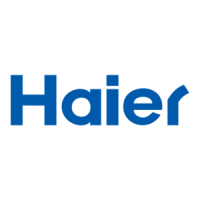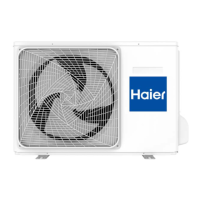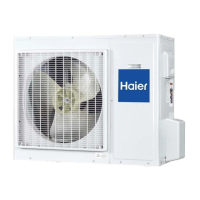Loading and Unloading/Transporting Management/Storage Requirements
Loading and Unloading Requirements
1) The products shall be carefully handled during loading and unloading.
2) Rude and barbarous handling such as kicking, throwing, dropping, bumping, pulling and rolling is not
allowed.
3) The workers engaged in loading and unloading must be subject to necessary trainings on the potential
hazards caused by barbarous handling.
4) Dry powder extinguishers or other suitable fire extinguishing apparatus within the period of validity shall be
equipped at the loading and unloading site.
5) The untrained personnel cannot be engaged in loading and unloading of flammable refrigerants air
conditioner.
6) Before loading and unloading, anti-static measures shall be taken, and phones cannot be answered during
loading and unloading.
7) Smoking and open fire are not allowed around the air conditioner.
Transporting Management Requirements
1) The maximum transporting volume of finished products shall be determined as per local regulations.
2) The vehicles used for transporting shall be operated as per local laws and regulations.
3) Dedicated after-sales vehicles shall be used for maintenance, and exposed transporting of refrigerant
cylinders and the products to be maintained is not allowed.
4) The rain cover or similar shielding material of transporting vehicles shall be provided with certain flame
retardancy.
5) Leakage warning device of flamma
ble refrigerant shall be installed inside the closed-type compartment.
6) Anti-static device shall be equipped inside the compartment of transporting vehicles.
7) Dry powder extinguishers or other suitable fire extinguishing apparatus within the period of validity shall be
equipped inside the driver's cab.
8) Orange-white or red-white reflective stripes shall be pasted on the sides and tail of the transporting vehicles,
to remind the vehicles behind of keeping distance.
9) The transporting vehicles shall run at a constant speed, and heavy acceleration/deceleration shall be avoided.
10) Combustibles or the static articles cannot be transported simultaneously.
11) High-temperature area shall be avoided during transporting, and necessary radiating measures shall be taken
in case the temperature inside the compartment is too high.
Storage Requirements
1) The storage package of equipment used shall be such that no leakage of refrigerant will be caused due to
mechanical damage of the equipment inside.
2) The maximum quantity of the equipment allowed to be stored together shall be determined as per local
regulations.
Installation Instructions
Installation Precautions
WARNING!
The area of the room in which R32 refrigerant air conditioner is installed cannot be less than the minimum
area specified in the table below, to avoid potential safety problems due to out-of-limit of refrigerant
concentration inside the room caused by leakage of refrigerant from refrigeration system of the indoor unit.
Once the horn mouth of connecting lines is fastened, it may not be used again (the air tightness may be
affected).
A whole connector wire shall be used for indoor/outdoor unit as required in the operation specification of
installation process and operation instructions.
Minimum Room Area
Type
LFL
kg/m3
hv
Total Mass Charged/kg
Minimum Room Area/m
2
R32 0.306
1.224 1.836 2.448 3.672 4.896 6.12 7.956
0.6 29 51 116 206 321 543
1.0 10 19 42 74 116 196
1.8 3 6 13 23 36 60
2.2 2 4 9 15 24 40
m
3
The maximum refrigerant charge amount (M)
Mkg Mkg
1.0
1.1
1.45
0.9
0.92
1.35
1.6
0.95 0.95
1.6
1U25S2SQ1FA
1U35S2SQ1FA
1U50S2SR1FA
1U70S2SR1FA
1U25BEFFRA
1U35BEFFRA
1U50JEFFRA
1U68REFFRA
1U25S2PJ1FA
1U35S2PJ1FA
unit model
unit model

